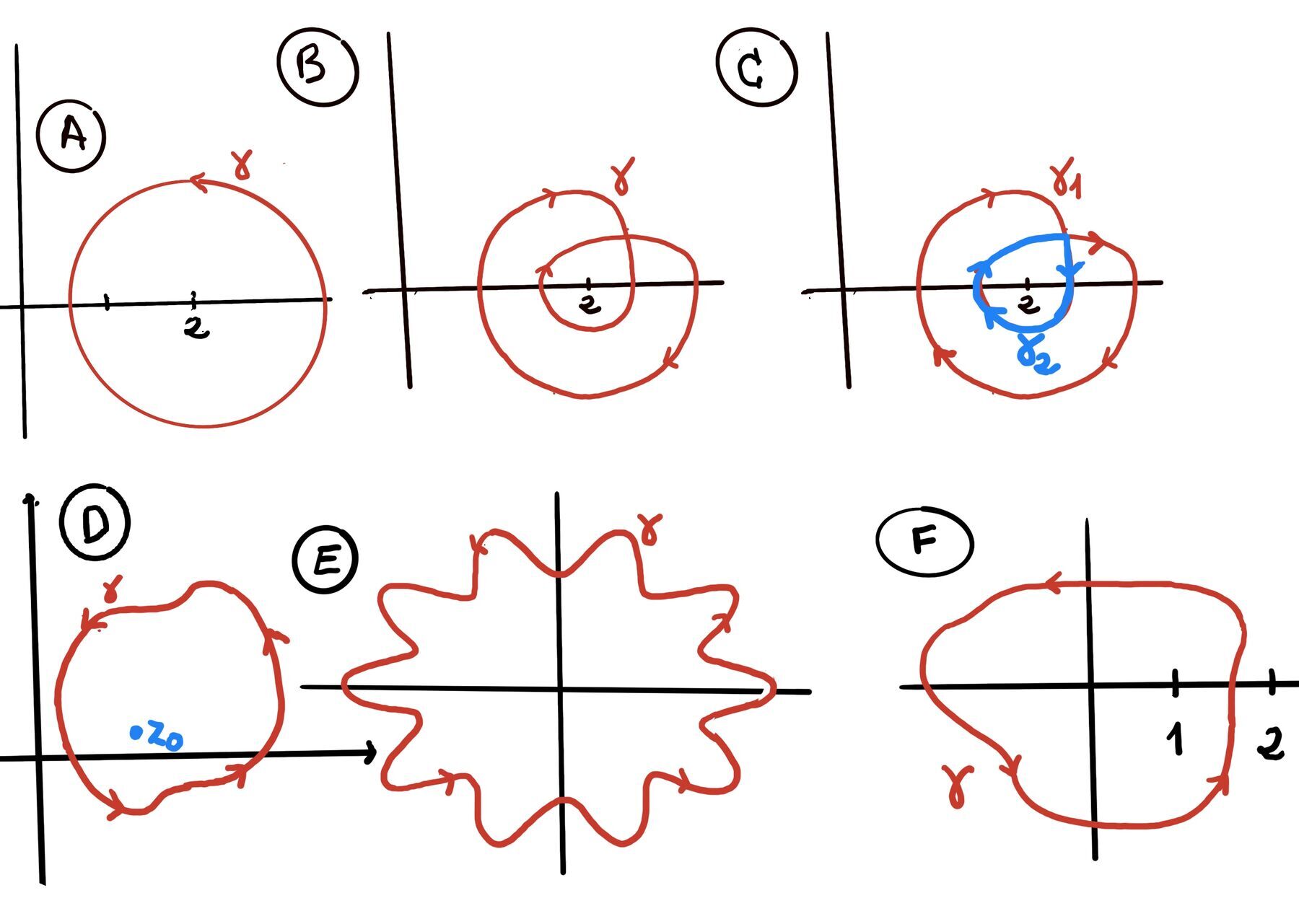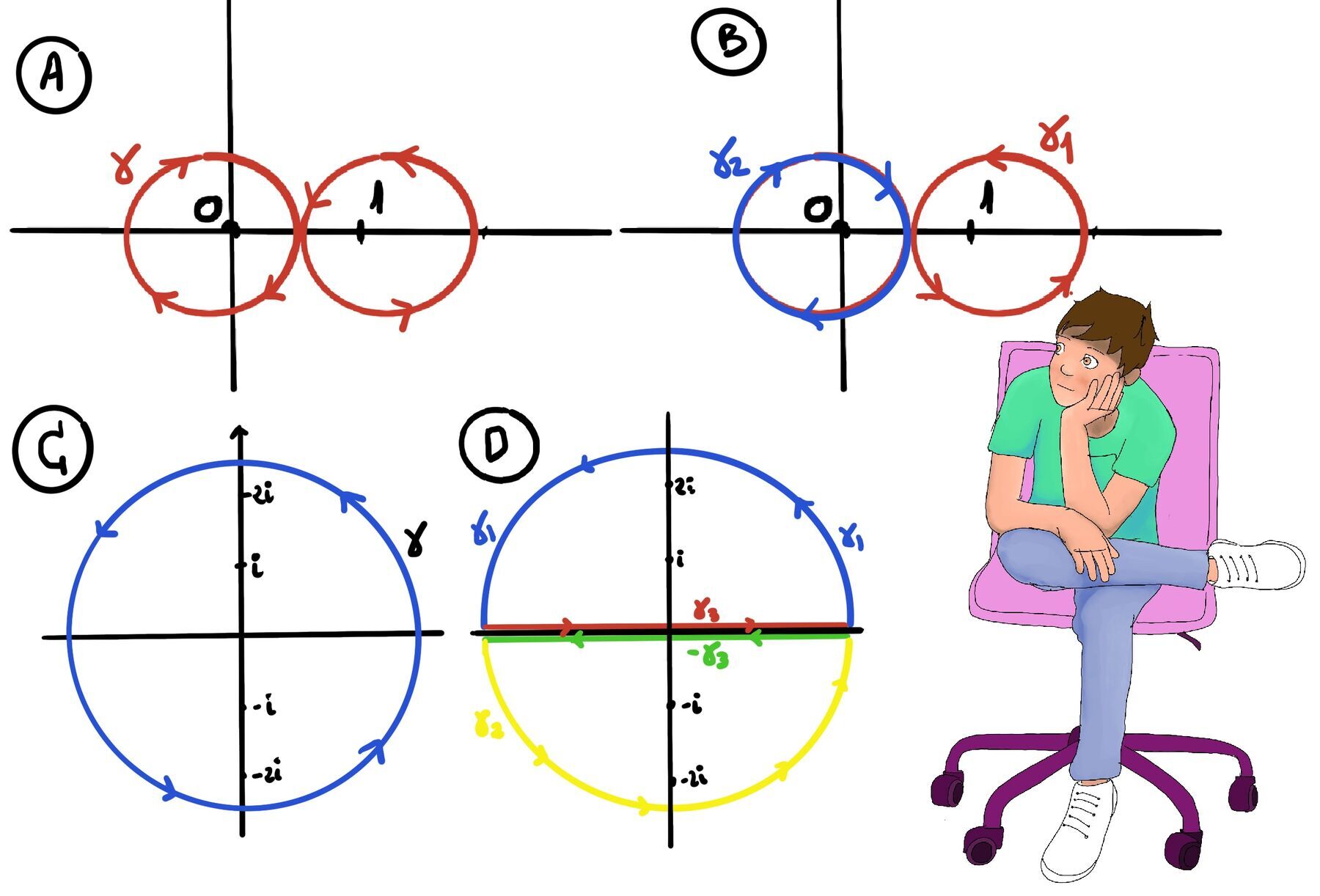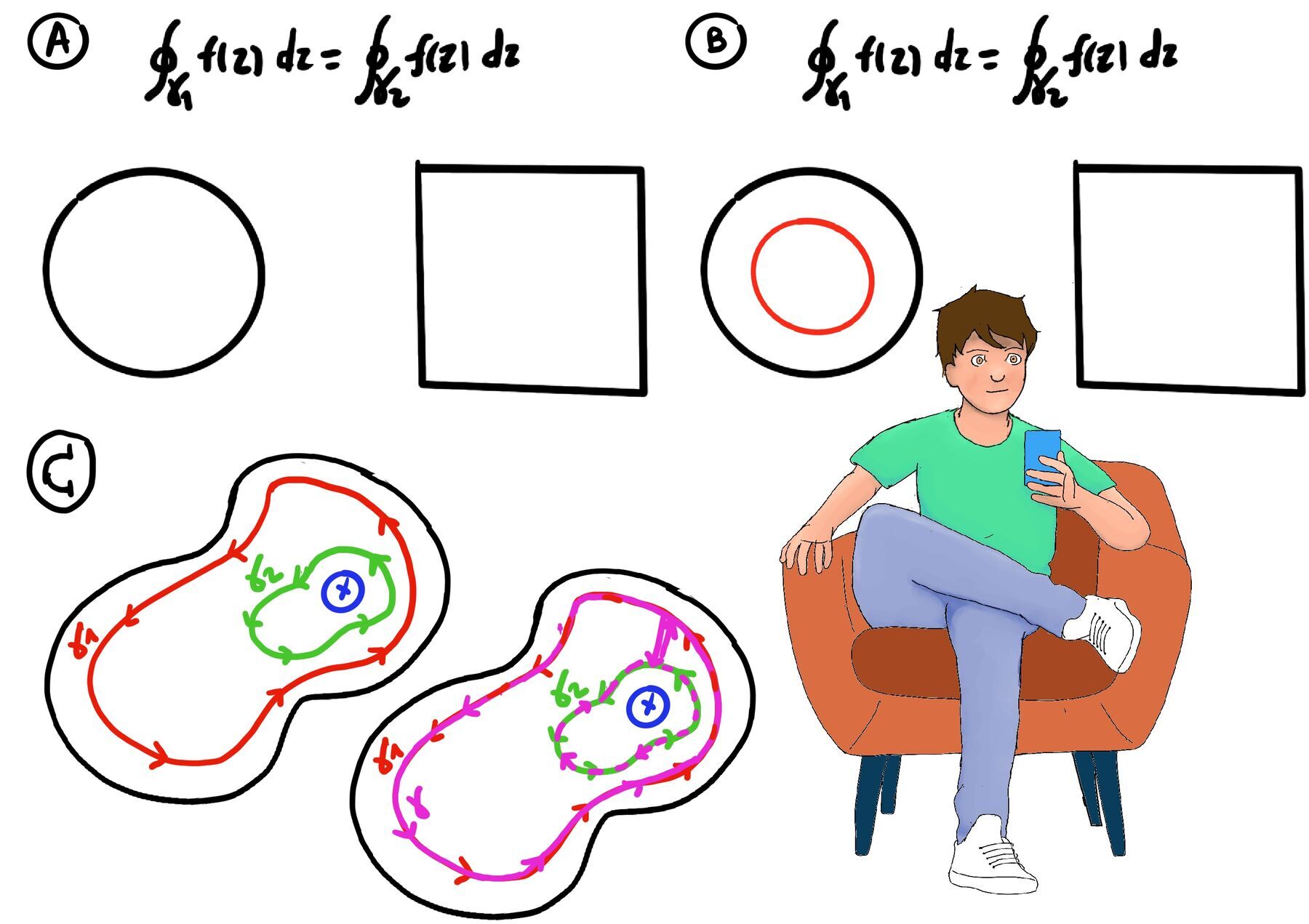
|
 |
 |
Silence is a source of great strength, Lao Tzu

A complex function $f(z)$ maps $z = x + iy \in \mathbb{C}$ to another complex number. For example: $f(z) = z^2 = (x + iy)^2 = x^2 - y^2 + 2ixy, f(z) = \frac{1}{z}, f(z) = \sqrt{z^2 + 7}$.
A contour is a continuous, piecewise-smooth curve defined parametrically as: $z(t) = x(t) + iy(t), \quad a \leq t \leq b$. Examples of contours:
Definition (Smooth Contour Integral). Let ᵞ be a smooth contour (a continuously differentiable path in the complex plane), $\gamma: [a, b] \to \mathbb{C}$. Let $f: \gamma^* \to \mathbb{C}$ be a continuous complex-valued function defined on the trace $\gamma^*$ of the contour (i.e. along the image of $\gamma$). Then, the contour integral of f along $\gamma$ is defined as $\int_{\gamma} f(z)dz := \int_{a}^{b} f(\gamma(t)) \gamma^{'}(t)dt$.

The formula can be used to calculate integrals: $\int_{\gamma} \frac{f(z)}{z-z_0}dz = 2\pi i \cdot f(z_0), \int_{\gamma} \frac{f(z)}{(z-z_0)^{(n+1)}}dz = \frac{2\pi i}{n!} \cdot f^{(n)}(z_0)$
Think of integrating an analytic function around a closed loop as a “free trip”—you always end up back where you started with a net result of zero.
However, if your function has singularities (points where it “blows up,” like poles), your path is no longer free. The Residue Theorem says that for every singularity you circle, you must “pay a toll.” The residue is the exact value of that toll. The total value of the integral is simply 2πi times the sum of all the “tolls” for the singularities you enclosed on your trip.
Calculate the Residues: $Res(f,0) = \lim_{z \to 0}(z - 0)\frac{z-1}{z(z-2)} = \lim_{z \to 0} \frac{z-1}{z-2} = \frac{-1}{-2}= \frac{1}{2}.$
$Res(f,2) = \lim_{z \to 2}(z - 2)\frac{z-1}{z(z-2)} = \lim_{z \to 2} \frac{z-1}{z} = \frac{1}{2}.$
$\oint_\gamma \frac{z-1}{z(z-2)}dz =[\text{Residue Theorem}] 2\pi i \sum Res(f, z_k) = 2\pi i[\frac{1}{2}+\frac{1}{2}] = 2\pi i$.
Proposition. Linearity of the contour integral. Let γ be a contour, defined by a function $\gamma: [a, b] \to \mathbb{C}$ and let f and g be continuous complex functions $f, g: \gamma^* \to \mathbb{C}$ defined along the image of ᵞ. Then, the contour integral satisfies the following linearity properties:
Proof:
Proof of Additivity. Consider the integral of the sum or difference of f and g:
$\int_\gamma \big(f(z)\pm g(z)\big)dz=\int_a^b \big(f(\gamma(t))\pm g(\gamma(t))\big) \gamma'(t) dt$
By the linearity of the ordinary complex integral (which follows from the linearity of ordinary real integrals for real and imaginary parts), we can distribute the integral:
$=\int_a^b f(\gamma(t))\,\gamma'(t)dt \pm \int_a^b g(\gamma(t)) \gamma'(t) d$$
Recognizing these as contour integrals of f and g respectively:
$=\int_\gamma f(z)\,dz \;\pm\; \int_\gamma g(z)\,dz.$
Proof of Homogeneity. Now consider the integral of a scalar multiple of f:
$\int_\gamma a\,f(z) dz = \int_a^b \big(a\,f(\gamma(t))\big) \gamma'(t) dt$
Since a is a constant, we can factor it out of the integral (again, by the linearity of the ordinary complex integral):
$=a\int_a^b f(\gamma(t))\gamma'(t)dt$
This is exactly a times the contour integral of f:
$=a\int_\gamma f(z) dz.$
Key insights:
Proposition. Properties of contour integrals under path manipulation. Let γ be a contour, defined by a function $\gamma: [a, b] \to \mathbb{C}$ and let f be a continuous functions $f: \gamma^* \to \mathbb{C}$ defined along the image of ᵞ. Then,
This proposition establishes that contour integrals are invariant under orientation-preserving reparameterizations of the contour. The key conditions are: (i) $\tilde{\gamma}$ is a reparameterization of γ via ψ; (ii) ψ has a positive continuous derivative (ensuring ψ is strictly increasing and differentiable). The positive derivative condition is crucial as it guarantees: (1) ψ is a bijection between [c, d] and [a, b]; (2) The substitution in the proof is valid; (3) The orientation of the contour is preserved.
The integral depends only on the geometric path taken and its orientation, not on how it’s parameterized. Reversing the orientation will multiply the result by -1, but any other smooth reparameterization that preserves the orientation leaves the integral unchanged. This property allows flexibility in choosing parameterizations for contour integrals and mirrors the substitution rule for definite integrals in real analysis, where the integral remains invariant under appropriate substitutions. However, while reversing orientation changes the sign of the integral, reparameterization with a positive derivative preserves both the value and the orientation.
Proof.
1. Reversal of orientation
The reversed contour $-\gamma$ is defined by $(-\gamma)(t) = \gamma(a + b - t)$ which traverses $\gamma$ backward.
The contour integral along $-\gamma$ is: $\int_{-\gamma} f(z) dz = \int_a^b f((-\gamma)(t)) \cdot (-\gamma)'(t) dt$
First, compute the derivative of $-\gamma$: $(-\gamma)'(t) = \frac{d}{dt} [\gamma(a + b - t)] =[\text{By the chain rule}] \gamma'(a + b - t) \cdot (-1) = -\gamma'(a + b - t)$
Substitute into the integral: $\int_{-\gamma} f(z) dz = \int_a^b f(\gamma(a + b - t)) \cdot \left(-\gamma'(a + b - t)\right) dt = -\int_a^b f(\gamma(a + b - t)) \gamma'(a + b - t) dt$
Now make a change of variables. Let $u = a + b - t$. Then: $du = -dt$. When $t = a, u = b$. When $t = b$, $u = a$
The integral becomes: $-\int_a^b f(\gamma(a + b - t)) \gamma'(a + b - t) dt = -\int_b^a f(\gamma(u)) \gamma'(u) (-du) = \int_b^a f(\gamma(u)) \gamma'(u) du$
Reversing the limits:
$= -\int_a^b f(\gamma(u)) \gamma'(u) du$
Recognize that this is the negative of the contour integral along γ:$= -\int_{\gamma} f(z) dz$
Thus, we have shown: $\boxed{\int_{-\gamma} f(z) dz = -\int_{\gamma} f(z) dz}$ as required.
Examples:
If $\gamma$ is the line between 0 and 1 along the real axis (it can be parametrized by $\gamma(t) = 0 + t\cdot (1-0) = t, 0 \le t \le 1, \gamma'(t) = 1$), then $-\gamma$ is the line between 1 and 0 (it can be parametrized by $-\gamma(t) = 1 + t\cdot (0-1) = 1 - t, 0 \le t \le 1, -\gamma'(t) = -1$). For the analytic function f(z)=z we compute the line integral directly, $\int_{-\gamma} zdz =[\text{Reversing the Contour/orientation}] -\int_{\gamma} zdz = -\int_0^1 tdt = -\frac{t^2}{2}\Big|_{0}^{1} = -\frac{1}{2}$
Let $\gamma$ be the quarter-circle arc from 1 to i along the first quadrant of the unit circle (it can be parametrized by $\gamma(t)=e^{it}$ for $0 \le t \le \pi/2$), then $-\gamma$ is the same quarter-circle arc from i back to 1 (it can be parametrized by $-\gamma(t) = e^{i(\pi/2 - t)}$ for $0 \le t \le \pi/2$).
For the analytic function f(z)=z we compute the line integral directly, $\int_{-\gamma} zdz =[\text{Reversing the Contour/orientation}] -\int_{\gamma} zdz = -\int_0^{\frac{\pi}{2}} e^{it}ie^{it}dt = -i\int_0^{\frac{\pi}{2}} e^{2it}dt = -i\left[ \tfrac{e^{2it}}{2i} \right]_0^{\pi/2} = -\tfrac{1}{2}\left(e^{i\pi} - e^{0}\right) = -\tfrac{1}{2}\left(-1 - 1\right) = 1.$
Direct Computation on $-\gamma$.
$\int_{-\gamma} zdz = \int_0^{\frac{\pi}{2}} e^{i(\pi/2 - t)}\cdot (-ie^{i(\pi/2 - t)})dt = -i\int_0^{\frac{\pi}{2}} e^{2i(\pi/2 - t)}dt = -i\int_0^{\frac{\pi}{2}} e^{i\pi}e^{-2it}dt[e^{\pi i} = -1] =$
$= i\int_0^{\frac{\pi}{2}}e^{-2it}dt = \left[ \tfrac{e^{-2it}}{-2} \right]_0^{\frac{\pi}{2}} = \frac{1}{2}-\frac{-1}{2} = 1.$
2. Additivity under Subdivision
Let c be a point such that a < c < b. Define: $\gamma_1 = \gamma|_{[a, \gamma_1]}$ (the restriction of γ to [a, c]) and $\gamma_2 = \gamma|_{[c, b]}$ (the restriction of γ to [c, b]).
The contour integral along γ is: $\int_{\gamma} f(z) dz = \int_a^b f((\gamma)(t)) \cdot (\gamma)'(t) dt$
By the additive property of definite integrals (for real integrals) $\int_a^b f(x)dx = \int_a^c f(x)dx + \int_c^b f(x)dx$, we can split the integral at t = c:
$ \int_a^b f((\gamma)(t)) \cdot (\gamma)'(t) dt = \int_a^c f((\gamma)(t)) \cdot (\gamma)'(t) dt + \int_c^b f((\gamma)(t)) \cdot (\gamma)'(t) dt$
The first and second integrals are exactly the contour integral on the subpaths γ1 and γ2 respectively. Therefore, $\int_{\gamma} f(z) dz = \int_{\gamma_1} f(z) dz + \int_{\gamma_2} f(z) dz$ which is exactly the stated property.

Therefore, we split the curve into two pieces (half upward/downward semicircles), where $\gamma_3$ is traversed both forward and backward, so its contributions cancel. Thus, $\gamma = \text{piece1 + piece2} = \gamma_1 + \gamma_3 -\gamma_3 + \gamma_2$ as shown in Figure D. Both of these two new pieces are simple and each surround just one singularity. Piece 1 encloses only the singularity at z = 2i and Piece 2 encloses only the singularity at z = -2i.
$$ \begin{aligned} \oint_\gamma \frac{z}{z^2+4}dz &=\oint_\gamma \frac{z}{(z-2i)(z+2i)}dz \\[2pt] &=\oint_{piece1} \oint_{piece2} \frac{\frac{z}{z+2i}}{z-2i}dz + \frac{\frac{z}{z-2i}}{z+2i}dz\\[2pt] &=\oint_{-\gamma_3 + \gamma_2} \frac{\frac{z}{z+2i}}{z-2i}dz + \oint_{\gamma_1 + \gamma_3} \frac{\frac{z}{z-2i}}{z+2i}dz\\[2pt] &=\text{Cauchy's Integral formula}\\[2pt] &=2\pi i \frac{2i}{2i+2i} + 2\pi i \frac{-2i}{-2i-2i}\\[2pt] &=2\pi i (\frac{1}{2}+\frac{1}{2})= 2\pi i. \end{aligned} $$The quickest way to solve this is by applying Cauchy’s Integral Theorem. The function being integrated is f(z) = z². As a polynomial, it is analytic (differentiable everywhere) in the entire complex plane. The path γ (a line segment joined to a semicircle) is a simple closed contour.
Cauchy’s Integral Theorem states that the integral of an analytic function over any simple closed contour is zero. Therefore, we can immediately conclude: $\int_{\gamma} z^2dz = 0$.
We can confirm this result by calculating the integral along the two separate paths, γ₁ and γ₂, and adding them together.
$\int_{\gamma} z^2dz = \int_{\gamma_1} z^2dz + \int_{\gamma_2} z^2dz$
$\int_{\gamma_1} z^2dz = \int_{-1}^1 (Rt)^2 \cdot R dt = R^3 \int_{-1}^1 t^2dt = R^3 \frac{t^3}{3}\Big|_{-1}^{1} = \frac{2R^3}{3}$
$\int_{\gamma_2} z^2dz = \int_{0}^{\pi} (Re^{it})^2 \cdot iRe^{it} dt = iR^3\int_{0}^{\pi} e^{3it} = iR^3 \frac{e^{3it}}{3i}\Big|_{0}^{\pi} = \frac{R^3}{3}(e^{3i\pi} - e^{0}) = \frac{R^3}{3}(-1-1) = -\frac{2R^3}{3}$
$\int_{\gamma} z^2dz = \int_{\gamma_1} z^2dz + \int_{\gamma_2} z^2dz = \frac{2R^3}{3} -\frac{2R^3}{3} = 0.$ The direct calculation confirms the result from Cauchy’s Theorem.
3. Invariance of Contour Integrals Under Reparameterization
Proof of Invariance of Contour Integrals Under Reparameterization
Since $\tilde{\gamma} = \gamma \circ \psi$, we can apply the chain rule: $\tilde{\gamma}'(t) = \gamma'(\psi(t))\psi'(t)$.
By definition, the contour integral along $\tilde{\gamma}$ is:
$\int_{\tilde{\gamma}} f(z)dz = \int_{c}^{d} f(\tilde{\gamma}(t))\tilde{\gamma}'(t)dt =[\text{Substitute into the integral}] \int_{c}^{d}(f(\gamma(\psi(t))))\gamma'(\psi(t))\psi'(t)dt$
Make the substitution $\tau = \psi(t). Then, d\tau = \psi'(t)dt$. When t = c, $\tau = \psi(c) = a$. when t = d, $\tau = \psi(d) = b$
Since ψ′(t) > 0 for all t ∈ [c, d], the function ψ is strictly increasing, so the substitution is valid. Therefore, the integral becomes.
$\int_{\tilde{\gamma}} f(z)dz = \int_{a}^{b}(f(\gamma(\tau)))\gamma'(\tau)d\tau = \int_{\gamma} f(z)dz$. This completes the proof.
Examples.
Define the reparameterization function $\psi : [1, \sqrt{2}] \to [1, 2], \psi(t) = t^2$ so that $\psi(1) = 1, \psi(\sqrt{2}) = 2, \psi'(t) = 2t \gt 0 ∀t \in [1, \sqrt{2}]$ (since t ≥ 1), and $\psi$ is continuous on $[1, \sqrt{2}]$
The reparameterized curve is $\tilde{\gamma} = \gamma \circ \psi$, so $\tilde{\gamma}(t) = \gamma(\psi(t)) = \gamma(t^2) = t^2 + it^2$ for $t \in [1, \sqrt{2}]$
This traces the same line segment from 1+i to 2+2i, but with a different parameterization. By the proposition, for any continuous function f defined on this line segment: $\int_{\gamma} f(z)dz = \int_{\tilde{\gamma}} f(z)dz$
Let f(z) = z, which is continuous on the line segment. Compute the Integral Along γ: $\int_{\gamma} f(z)dz = \int_1^2 (t + it)(1 + i) dt = \int_1^2 (1 + i)^2\cdot t dt = [\text{Since } (1 + i)^2 = 1 + 2i + i^2 = 2i] \int_1^2 t \cdot 2i dt = $
$2i \int_1^2 t dt = 2i \left[ \frac{t^2}{2} \right]_1^2 = 2i \cdot \frac{4 - 1}{2} = 2i \cdot \frac{3}{2} = 3i.$
Compute the Integral Along $\tilde{\gamma}$. $\int_{\tilde{\gamma}} f(z)dz = \int_1^{\sqrt{2}} (t^2 + i t^2) \cdot 2t(1 + i) dt = \int_1^{\sqrt{2}} t^2(1 + i) \cdot 2t(1 + i) dt = \int_1^{\sqrt{2}} 2t^3 (1 + i)^2 dt = [\text{Since } (1 + i)^2 = 1 + 2i + i^2 = 2i] \int_1^{\sqrt{2}} 2t^3 \cdot 2i dt.$
$= 4i \int_1^{\sqrt{2}} t^3 dt = 4i \left[ \frac{t^4}{4} \right]_1^{\sqrt{2}} = i \left[ t^4 \right]_1^{\sqrt{2}} = i \left( (\sqrt{2})^4 - 1^4 \right) = i(4 - 1) = 3i.$ Both integrals yield the same value. This confirms the invariance of contour integrals under reparameterization.
Define the reparameterization function $\psi : [0, 2π] \to [0, π], \psi(t) = \frac{t}{2}$ so that $\psi(0) = 0, \psi(2π) = π, \psi'(t) = \frac{1}{2} \gt 0 ∀t \in [0, 2π]$ and $\psi$ is continuous on $[0, 2π]$.
The reparameterized curve is $\tilde{\gamma} = \gamma \circ \psi$, so $\tilde{\gamma}(t) = \gamma(\psi(t)) = \gamma(\frac{t}{2}) = e^{i(t/2)}$ for $t \in [0, 2\pi]$ which traces the same upper half of the unit circle.
By the proposition, for any continuous function f defined on this line segment: $\int_{\gamma} f(z)dz = \int_{\tilde{\gamma}} f(z)dz ↭ \int_{\gamma} f(z)dz = \int_0^{2\pi} f(e^{i(t/2)}) \cdot \left(i \cdot \frac{1}{2} e^{i(t/2)}\right) dt$
Now, let f(z) = $\frac{1}{z}$, which is continuous on the curve (since the curve does not pass through z = 0). Compute the integral along $\gamma$.
$\int_\gamma f(z) dz = \int_0^\pi \frac{1}{e^{it}} \cdot i e^{it} dt = \int_0^\pi i dt = i \left[ t \right]_0^\pi = i\pi.$
Compute the integral along $\tilde{\gamma}$.
$\int_{\tilde{\gamma}} f(z) dz = \int_0^{2\pi} \frac{1}{e^{i t/2}} \cdot \frac{i}{2} e^{i t/2} dt = \int_0^{2\pi} \frac{i}{2} dt = \frac{i}{2}\left[ t \right]_0^2\pi = \frac{i}{2} \cdot 2\pi = i\pi$.
Both integrals yield the same value. This confirms the invariance of contour integrals under reparameterization.
Key Idea: If a function f(z) is analytic in a region D, the integral over any closed contour in D is zero (by Cauchy’s theorem). Deforming a contour is valid only if the entire region between the original and deformed contours is free of singularities.
The integral $ \int_{\gamma} \frac{1}{z} dz$ is the same for any closed contour $\gamma$ enclosing the origin. For example, a circle |z| = 1 and an ellipse |z - 0.5| = 0.5 both give $2\pi i$.
The function f(z) = 1/z has a singularity at z = 0. For any closed contour γ that encloses the origin (with positive orientation), the integral is: $ \int_{\gamma} \frac{1}{z} dz$
Note: For a simple pole at a point $z_k$ (i.e., the denominator has a simple root) is calculated using the formula $Res(f, z_k) = \lim_{z \to z_k}(z-z_k)f(z)$. In our particular case, $Res(f, z_0) = \lim_{z \to 0}(z-0)\frac{1}{z} = 1.$.
The Cauchy-Goursat theorem states that if a function f is analytic at all points inside and on a simple closed contour γ, then: $\oint_{\gamma} f(z)dz = 0$.
However, when dealing with functions that are not analytic everywhere, such as ($f(z) = \frac{1}{z}$), the principle of deformation of contours becomes essential. f(z) is analytic everywhere except at z = 0, where it has a simple pole. If a contour encloses this singularity, the integral may be nonzero. For instance, over the unit circle centered at the origin: $\oint_{\gamma_2}\frac{1}{z} = 2\pi i$.
To illustrate this principle, consider two contours: ($\gamma_1$), a square centered at the origin, and ($\gamma_2$), a unit circle also centered at the origin (Figure A). While the integral of ($f(z) = \frac{1}{z}$) over the unit circle has been previously calculated as $2\pi i$, the integral over the square requires a different approach.
Using the principle of deformation of contours, one can replace ($\gamma_1$) and ($\gamma_2$) with new contours that are entirely contained within regions where the function remains analytic. For instance, if an inner circle ($\gamma_2$) with radius ($\frac{1}{2}$) is considered, the integral along this path will also yield ($2\pi i$) because the function remains analytic between the two curves (Figure B).
The theoretical foundation of the deformation principle can be visualized by constructing a new contour that connects points on ($\gamma_1$) and ($\gamma_2$). By creating a “bridge” between these contours, one can define a closed path that encircles a simply connected region:
Consequently, the integral along ($\gamma_1$) equals the integral along ($\gamma_2$) (Figure C). An integral is unchanged under continuous contour deformation provided the integrand stays analytic throughout the region swept out.
